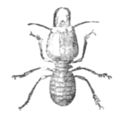A brief description of the Termites, or white ants, may appropriately conclude the present article. These forms have already been stated to be entirely different from the familiar and true ants, and to belong to the Neuropterous insects, whereas the true ants are classed with the Hymenoptera. They resemble the true ants in living in highly organised social communities, and in being endowed with as high and as specialised instincts. But they differ from them, first, in the fact that they do not undergo a complete metamorphosis, that is, the Termite larvae and pupae resemble the perfect insect, and do not pass through the defined stages of change and development characteristic of the true ants, bees, and other insects. The young Termite, in fact, differs from the ordinary adult only in the nonpossession of eyes, and from the sexual forms in the nondevelopment of wings. The white ants inhabit the tropical regions of the world generally, but are found in the greatest abundance in tropical South America. Their nests form characteristic structures, rising sometimes to a height of 5 or 6 feet, and constructed of earthy particles worked into a mass as hard and durable as stone. Many species of Termites are known, but they resemble one another in essential structure and habits. As indicated by their popular name, they are of a whitish colour and are soft-bodied. The Termite community consists, as in the true ants, of males, females, and workers or neuters. In the true ants the latter are undeveloped females, whereas in the Termites the sex of the neuters is wholly undeterminable; and in addition the workers are invariably divided into two distinct classes: the " soldiers/ with largely-developed jaws, whose sole office is to defend the community; and the ordinary " workers," on whom devolves the entire labour of the nest. Both classes of neuters are blind; and from a close examination of the eggs, the distinctions, not only between males and females, but also between the soldiers and workers, may be easily seen. The difference in food, so powerful in the development of sex and characteristics in other insects, does not therefore operate in the case of the Termites. The entire white ant colony and species also exhibits a division into subordinate groups and classes, the recognition and characters of which are very difficult of determination. And on this, as well as upon other grounds, the organisation of the white ant community is generally to be regarded as of a higher type than that of the familiar and true ants.
The nest of the Termites is known as a termitarium, the essential internal arrangement of which consists of a large number and series of chambers, connected by galleries and passages. Entrance to the nest is afforded by con cealed roads and subterranean passages. A large hillock may be a compound termitarium, formed by and inhabited by different species; and certain kinds of Termites build their nests of smaller size, sometimes of the consistence of paper. Their structures may be attached to the branches of trees, or they may be entirely subterranean, or concealed under the bark or within the stems of trees. The latter species are those which destroy timber, furniture, and household objects.
Within this curious home an equally curious community is found to reside. The king and queen represent the sexual part of the community, the true neuters or workers form the greater part of the ordinary individuals, and the soldiers and winged Termites complete the list of inmates. The royal cells, tenanted by the king and queen, exist in the inmost part of the nest, and are closely guarded by a retinue of workers. The king and queen are wingless and much larger than the neuter ants. The queen Termite when within the royal cell is permanently gravid, the abdomen being immensely distended with eggs, which as they are produced, are seized upon by the workers, and conveyed to special cells prepared for their reception. The relations of the winged Termites to the other members of the nest long formed a subject of great difficulty to naturalists; but they appear to be males and females, which are ready to assume sexual relations, and to become the progenitors or kings and queens of new communities. The neuters are, accordingly, quite distinct from the sexual forms, and do not pass through any similar developmental phases, but differ from the others, even in the egg, as has been already mentioned. Occasionally a new termitarium may be found, in which a king and queen are absent, and which contains workers only. These, however, gradually prepare the nest for full completion, by bringing eggs into the cells from a neighbouring termitarium, from which the due population of the colony will be in time produced.



